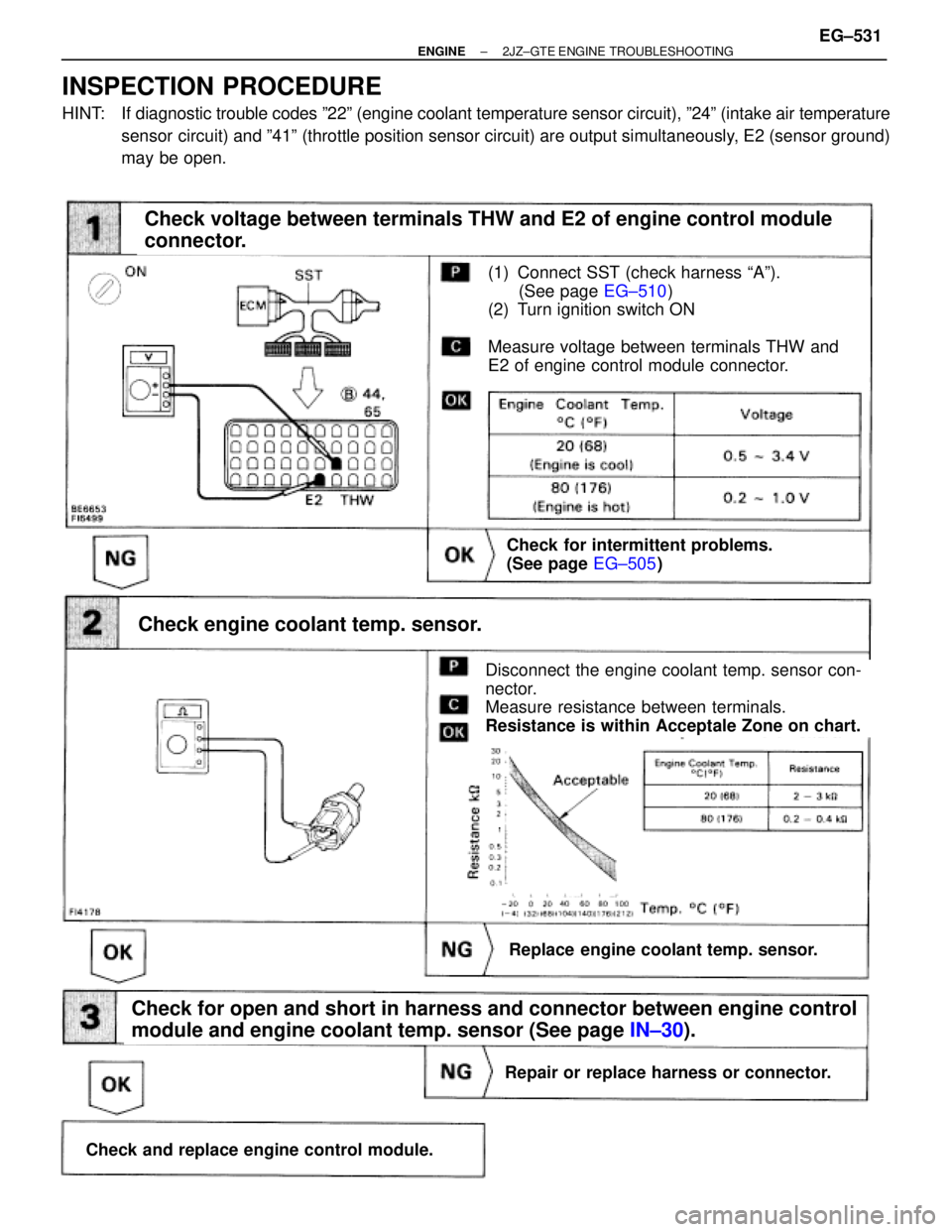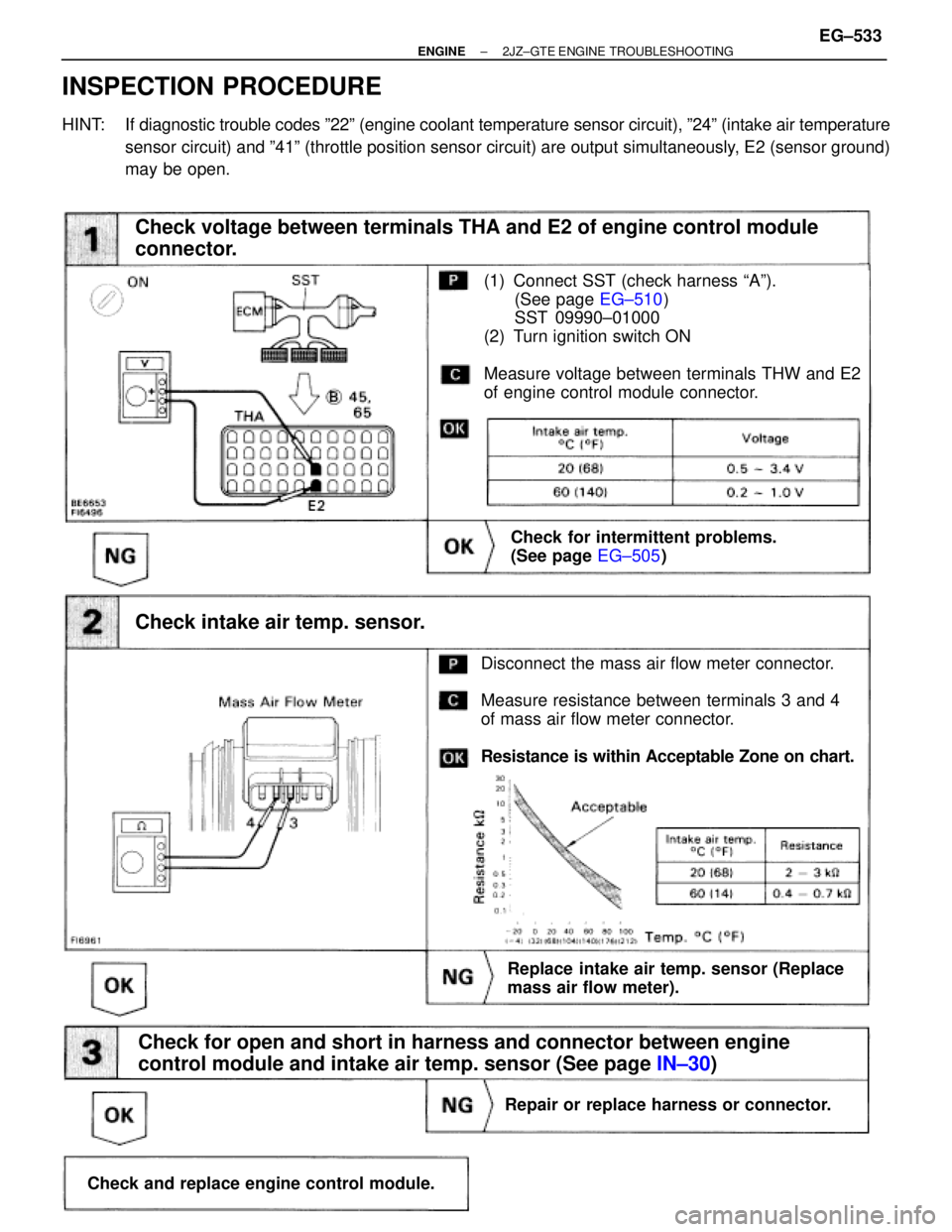Page 2037 of 2543

CIRCUIT DESCRIPTION
The engine coolant temperature sensor senses the
coolant temperature. A thermistor built in the sensor
changes its resistance value according to the coolant
temperature. The lower the coolant temperature, the
greater the thermistor resistance value, and the high-
er the coolant temperature, the lower the thermistor
resistance value (See Fig. 1).
The engine coolant temperature sensor is connected
to the ECM (See wiring diagram). The 5 V power
source voltage in the ECM is applied to the engine
coolant temperature sensor from the terminal THW
via a resistor R. That is, the resistor R and the engine
coolant temperature sensor are connected in series.
When the resistance value of th engine coolant tem-
perature sensor changes in accordance with changes
in the coolant temperature, the potential at the termi-
nal THW also changes. Based on this signal, the ECM
increases the fuel injection volume to improve drive-
ability during cold engine operation. If the ECM re-
cords the diagnostic trouble code 22, it operates the
fail safe function in which the engine coolant tempera-
ture is assumed to be 80°C (176°F).
Diagnostic Trouble Code Detecting ConditionDTC No.Trouble Area
Open or short in engine coolant temp. sensor
circuit for 0.5 sec. or more�Open or short in engine coolant temp.
sensor circuit
�Engine coolant temp. sensor
�ECM
DTC 22 Engine Coolant Temp. Sensor Circuit
EG±530± ENGINE2JZ±GTE ENGINE TROUBLESHOOTING
Page 2038 of 2543

(See page EG±510)
(1) Connect SST (check harness ªAº).
(See page EG±510)
(2) Turn ignition switch ON
Measure voltage between terminals THW and
E2 of engine control module connector.
Check voltage between terminals THW and E2 of engine control module
connector.
Check for intermittent problems.
(See page EG±505)
Disconnect the engine coolant temp. sensor con-
nector.
Measure resistance between terminals.
Resistance is within Acceptale Zone on chart.
Check engine coolant temp. sensor.
Replace engine coolant temp. sensor.
Repair or replace harness or connector.
Check and replace engine control module.
Check for open and short in harness and connector between engine control
module and engine coolant temp. sensor (See page IN±30).
INSPECTION PROCEDURE
HINT: If diagnostic trouble codes º22º (engine coolant temperature sensor circuit), º24º (intake air temperature
sensor circuit) and º41º (throttle position sensor circuit) are output simultaneously, E2 (sensor ground)
may be open.
± ENGINE2JZ±GTE ENGINE TROUBLESHOOTINGEG±531
Page 2039 of 2543

DTC 24 Intake Air Temp. Sensor Circuit
CIRCUIT DESCRIPTION
The intake air temp. sensor is built into the mass air flow meter and senses the intake air temperature. The struc-
ture of the sensor and connection to the ECM is the same as in the engine coolant temp. sensor shown on page
EG±530.
If the ECM detects the diagnostic trouble code º24º, it operates the fail safe function in which the intake air tem-
perature is assumed to be 20°C (68°F).
����� �
���� �����DTC No.
���������������� �
��������������� ����������������Diagnostic Trouble Code Detecting Condition
���������������� �
���������������
����������������
Trouble Area
����� �
���� �
���� �
���� �����
24
���������������� �
��������������� �
��������������� �
��������������� ����������������
Open or short in intake air temp. sensor circuit
for 0.5 sec. or more
���������������� �
���������������
����������������
����������������
����������������
�Open or short in intake air temp. sensor
�Circuit
�Intake air temp. sensor
�ECM
EG±532± ENGINE2JZ±GTE ENGINE TROUBLESHOOTING
Page 2040 of 2543

(See page EG±510)
(1) Connect SST (check harness ªAº).
(See page EG±510)
SST 09990±01000
(2) Turn ignition switch ON
Measure voltage between terminals THW and E2
of engine control module connector.
Check voltage between terminals THA and E2 of engine control module
connector.
Check for intermittent problems.
(See page EG±505)
Disconnect the mass air flow meter connector.
Measure resistance between terminals 3 and 4
of mass air flow meter connector.
Resistance is within Acceptable Zone on chart.
Check intake air temp. sensor.
Check for open and short in harness and connector between engine
control module and intake air temp. sensor (See page IN±30)
Replace intake air temp. sensor (Replace
mass air flow meter).
Repair or replace harness or connector.
Check and replace engine control module.
INSPECTION PROCEDURE
HINT: If diagnostic trouble codes º22º (engine coolant temperature sensor circuit), º24º (intake air temperature
sensor circuit) and º41º (throttle position sensor circuit) are output simultaneously, E2 (sensor ground)
may be open.
± ENGINE2JZ±GTE ENGINE TROUBLESHOOTINGEG±533
Page 2061 of 2543

INSPECTION PROCEDURE
HINT:
wIf diagnostic trouble code 41 is displayed, check throttle position sensor circuit. If diagnostic trouble code
47 is displayed, check sub±throttle position sensor circuit.
wIf diagnostic trouble code º22º (engine coolant temperature sensor circuit), º24º (intake air temperature
sensor circuit) and º41º (throttle position sensor circuit) are output simultaneously. E2 (sensor ground) may
be open.
(See page EG±505)
(See page EG±510)
(See page EG±292)
Check voltage between terminals VTA1, 2, IDL1, 2 and E2 of engine control
module connector.
The voltage should increase steadily in proportion
to the throttle valve opening angle.
(1) Connect SST (check harness ªAº).
(See page EG±510)
SST 09990±01000
(2) Turn ignition switch ON.
(3) For throttle position sensor, disconnect the vacuum
hose from the throttle body, then apply vacuum to
the throttle opener.
(See page EG±292)
(4) For sub±throttle position sensor, remove intake air
duct and disconnect sub±throttle valve step motor
connector.
Measure voltage between terminals VTA1, 2, IDL1,
2 and E2 of engine control module connector when
the (sub±) throttle valve is opened gradually from
the closed condition.
Check for intermittent problems.
(See page
EG±505)
Throttle Valve
Terminal
Fully Closed
Fully Open
EG±554± ENGINE2JZ±GTE ENGINE TROUBLESHOOTING
Page 2071 of 2543

See page EG±503.
CIRCUIT DESCRIPTION
The EGR system is designed to recirculate the exhaust gas, controlled according to the driving condi-
tions back into the intake air±fuel mixture. It helps to slow down combustion in the cylinder and thus
lower the combustion temperature which, in turn, reduces the amount of NO
x emission. The amount
of EGR is regulated by the EGR vacuum modulator according to the engine load.
If even one of the following conditions is fulfilled,
the VSV is turned ON by a signal from the ECM.
This resists in atmospheric air acting on the EGR
valve, closing the EGR valve and shutting off the
exhaust gas (EGR cut±OFF).
� Engine coolant temp. below 50°C (122°F)
� During deceleration (throttle valve closed)
� Light engine load (amount of intake air very
small)
� Engine speed over 4,800 rpm
� Manifold absolute pressure more than 120 kPa
(1.2 kgf/cm
2, 17.4 psi)
DTC No.Diagnostic Trouble Code Detecting ConditionTrouble Area
No No.1 knock sensor signal to ECM for 4
crank revolutions with engine speed between
2,050 rpm and 5,950 rpm
�Open EGR gas temp. sensor circuit
�Short in VSV circuit for EGR
�EGR hose disconnected, valve stuck
�Clogged EGR gas passage
�ECM
EGR gas temp. and intake air temp. are
60°C(140°F) or less for A/T, 55°C (131°F) or
less for M/T for 1 ~ 4 min. under conditions (a)
and (b):
(2 trip detection logic)*
(a) Engine coolant temp.: 60°C (140°F) or
more
(b) EGR operation possible (Example A/T in
3rd speed (5th for M/T), A/C ON, 96 km/h
(60 mph), Flat road)
Purpose of the driving pattern.
(a) To simulate diagnostic trouble code detecting condition after diagnostic trouble code is recorded.
(b) To check that the malfunction is corrected when the repair is completed by confirming that diagnos±
tic trouble code is no longer detected.
DIAGNOSTIC TROUBLE CODE DETECTION DRIVING PATTERN
DTC 71 EGR System Malfunction
EG±564± ENGINE2JZ±GTE ENGINE TROUBLESHOOTING
Page 2102 of 2543
VSV Circuit for Fuel Pressure Control
CIRCUIT DESCRIPTION
The ECM turns on a VSV (Vacuum Switching
Valve) to draw air into the diaphragm chamber
of the pressure regulator if it detects that the
temperature of the engine coolant is too high
during engine starting.
The air drawn into the chamber increases the
fuel pressure to prevent fuel vapor lock at high
engine temperature in order to help the en-
gine start when it is warm.
Fuel pressure control ends approx. 120 sec.
after the engine is started.
± ENGINE2JZ±GTE ENGINE TROUBLESHOOTINGEG±595